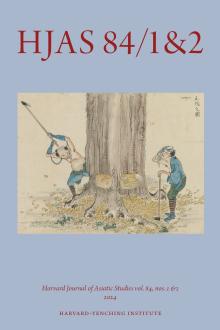June & December 2024
Illustration from Sanrin batsuzai zukai, Japan, [1700–1868], two scrolls, color painting on paper, 263 × 9,660 mm; 263 × 12,240 mm; Harvard-Yenching Library, Harvard University, Cambridge, MA, https://id.lib.harvard.edu/alma/99157739058003941/catalog. Image courtesy of Harvard-Yenching Library.
Editorial Preface
Articles
Old Chinese Coins in Medieval Japan
Between the late twelfth and mid-fourteenth centuries, copper coins, undervalued and demonetized by Chinese dynasties, travelled to Japan for use as bronze material rather than money. The development of copper mining in Japan in the fifteenth century caused dealers to stratify coins, using standard coin for large, distant transactions and operational coin for local ones. When the import of standard coin from China was suspended, rice was revived as the monetary unit for transactions in 1570s’ Japan. Local dealers changed consensus over what medium was to be used for transactions and what exchange rate was applied to standard coin. As late as the 1620s, brass copper coins newly issued by the Ming swept bronze copper coins bearing old era names from China. Responding to this trend on the continent, state-issued copper coins, such as the Kan’ei coin in Japan, swept away the actual free coinage system from East Asia.
中世日本列島に流通した通貨は中国古銭であった。当初は鐘や仏像を鋳造する素材需要を満たすため廃銭政策をとる中国から輸入された。硫化銅精錬による銅価格下落は古銭と模造古銭の差別化慣行をシナ海一帯にもたらしたが、寛永通宝鋳造は列島内通貨流通を独立させた。
Mountains, Woodsmen, and Village Conflicts in Japan, ca. 1200–1400
Woodlands were always abundant in Japan, but by the thirteenth century, the landscape in the central provinces began to change, giving rise to conflicts and violence. The difficulties builders faced procuring lumber for temples and palaces from the eighth century on is well known, but the impact of deforestation on rural society is not as well understood. By the Kamakura period, competition over woodland resources pitted old neighbors against each other and struggles ensued. Woodlands were only of peripheral interest to central powers, and conflicts over access to them were often left to locals to manage. Yet, effective mediation practices were developed and employed locally by the communities themselves, preventing conflicts from escalating. The story of deforestation and conflict mediation during the thirteenth and fourteenth centuries in the mountain community of Katsuragawa provides an opportunity to study the mechanics of local governance and agency, and helps challenge estate-based models of social control.
鎌倉時代までに、森林資源をめぐる競争は隣人同士の対立を引き起こした が、住民は効果的な調停方法を編み出し、紛争拡大を防いだ。鎌倉後期の葛川にお ける森林伐採と紛争調停の事例は、地域社会の統治仕組みや主体性を明らかにす る機会を提供する。
Representing the Nanban Moment
Gotō Thomé (1547?–1627)
Japan’s “Nanban Moment” has recently been defined as “a critical juncture in world history when for the first time all the major urban civilizations became interconnected.” These connections were political, economic, religious, literary, linguistic, and artistic in nature. This article presents the life of Gotō Thomé, a shopkeeper from Nagasaki’s Uchimachi district, drawing upon different Japanese and European sources. As mayor, he was one of four principal officials of the Inner City. A major silk dealer, he was a leading member of the national silk guild. As elder of the São Paulo parish and member of the Misericordia Brotherhood, he was the main lay spokesman for the Jesuit missionaries. As printer of the Japanese texts generated by the Jesuits, he supported a new literary movement in Japan. Finally, as the likely sponsor of Nanban art, he played an important role in creating the arts and crafts of Japan’s Christian experiment.
「南蛮渡来の瞬間」は、世界史の中で初めて全ての主要な都市文明が相互接続した重要な分岐点で、政治、経済、宗教、言語、そして芸術的な要素を持っていた。本稿は、長崎内町の商店主で吉利支丹であった後藤トメの生涯を、日本とヨーロッパの史料から紹介する。
Between Ritual and Theater
The Buddhist Play Guiyuanjing on the Page and Stage
This article examines the production and reception of a Buddhist play entitled Guiyuanjing, prefaced in 1650, written by the monk Zhida. Given the Buddhist precepts against playwriting and theatrical performance, Zhida attempted to reframe the dramatic genre to reconcile his dual identities as a monk and a playwright. He used paratexts to sacralize his work and transform its staging into a solemn Buddhist ritual, differentiating this play from both secular plays and popular ritual dramas. The medium of wood-block print preserved and largely realized his aspiration, but actual performances of the play constantly challenged his instructions by adapting it for court ceremonies to glorify Qing rulers or for twentieth-century commercial theaters to entertain and edify popular audiences. This case study offers an opportunity to investigate how different historical actors drew and blurred the distinctions between ritual and theater on their own terms in late imperial and modern China.
本文討論清初僧智達所撰戲曲《歸元鏡》的寫作與流傳。智達通過副文本將其演出定義為莊嚴的釋家儀式,後世諸刻本保存其規約,而清代至二十世紀的舞台搬演則不斷挑戰作者意圖,改編該劇以謳歌皇權或娛樂大眾。藉此個案可審視不同群體對戲劇與儀式邊界的差異化闡釋。
